How Tariffs, AI, and Robots Will Reshape Industry and Humanity
Tariffs are breaking old trade ties. AI and robots are rewriting the rules. The U.S.–China split is just the beginning of a new world map drawn in algorithms, not alliances.
Wealth is not an entitlement. It is a privilege. It comes with power and an ability to establish your set of values across the globe. Not creating networks to create such power is to lose it all.


Photo by Al Battison on Unsplash
“I live in a house over there on the Island, and in that house there is a man waiting for me. When he drove up at the door I drove out of the dock because he says I’m his ideal.” ― F. Scott Fitzgerald, Winter Dreams
NOTE: Due to personal commitments, we will not be able to write the newsletter for the rest of the week. Our next newsletter will be on Monday AM Indian Time/Sunday night US Time.
Money never goes to the person who has more money. It goes from those who do not know how to use the money to those who know how to use the money.
That is what the banks do in the first place.
They take money from those who don’t know how to use it and give it to those who know how to use it.
One of the uses of money is to create the ecosystem to earn more money. To create a society that empowers and buoys your way of life to ensure that the world shares your values and thus retains the arrangements that can help sustain your power.
Power that can allow money to be earned.
The trash can of history is littered with the once-rich idiots who thought local petty change grabbing was a great way to retain their wealth.
The smart play the larger geopolitical game.
Mansukh Hiren’s car was used to plant explosives at Antilla, Mukesh Ambani’s (India’s richest man) residence and then came the information that it was done by an Assistant Police Inspector (API) - Sachin Waze - who had been patronized by the Home Minister and the Mumbai Police Commissioner. This one action and a series of events before and after are the talk of the Indian talking heads.
Before it, the Ambani businesses were targeted with Jio cell towers uprooted in Punjab and Ambani being abused every day in press, social media and the protesting public.
In all the political brouhaha and din, no one seems to asking the most fundamental question:
Why is Mukesh Ambani so vulnerable?
From protesters, rumored to be funded by another global billionaire - with far lesser networth - to an API in Mumbai, everyone seems to be having a field day beating the crap out of the richest Indian and making a mincemeat of his reputation - which is inextricably linked to the future of his businesses.
How the heck are Mukesh Ambani and Gautam Adani missing the whole plot so spectacularly?
The billionaire ranked #162 is being shown to have invested smartly enough - via organizations like Human Rights Watch and Open Society Foundation (OSF) and his $1 billion fund to tackle the spread of “nationalism,” (Source) to have put the names and futures of other two billionaires ranked #155 and #21 in peril. (Issue #240 - Wajid Ali Shah Redux)
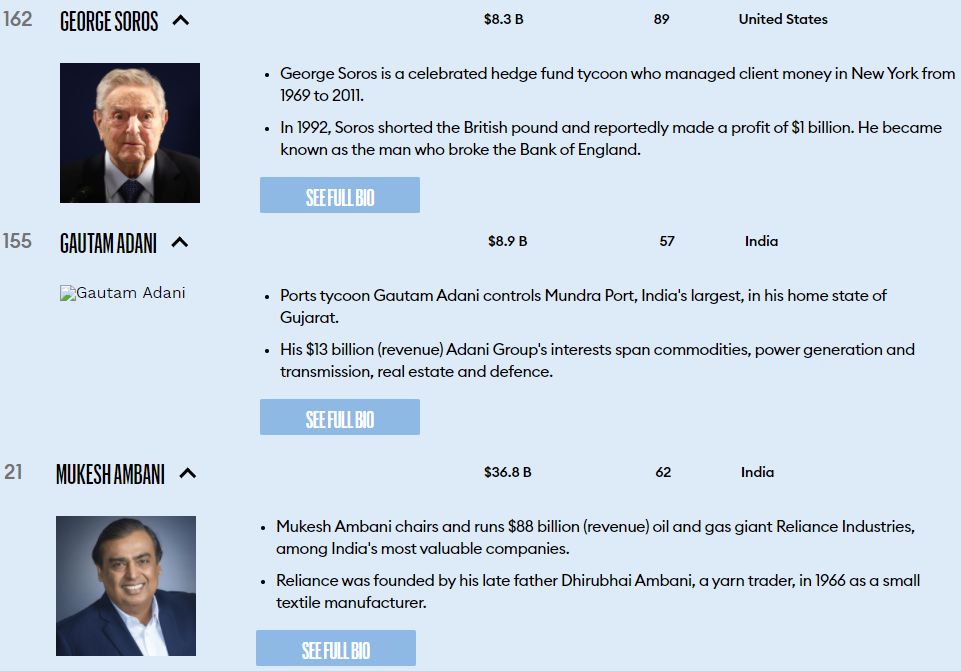
Today, let us look into the link between Politics, Business, Religion and power.
In the 12th century, a few family members moved from Cafaggiolo, a village in Tuscany to Florence. They ventured into the finance and banking business and in a few centuries, they would control not just the politics in Rome but even the Papacy.
The Medicis.
Their family genes are mixed in many European royal families. Four popes - Leo X, Clement VII, Pius IV, and Leo XI - came from the Medici family. (Source)
With the rise of Cosimo de’ Medici, the family’s support for the artists made Florence the capital of the Western Renaissance. Every great artist - Sandro Botticelli, Domenico Ghirlandaio, Andrea del Verrocchio, Leonardo da Vinci and Michelangelo Buonarroti (Source) - of that time found patronage in the Medici set up.
The last Medici ruler died in 1737 without an heir and so the most powerful financial and political dynasty ended.
Medicis’ influence was felt all over Europe. And via the Catholic Popes in the entire world.
Game was clear - to remain in power, one had to have a finger on the global pulse and a way to control the businesses, flow of money and power centers.
A verity that has been the consistent way to handle the bond between money and power by the most powerful leaders in Religion, Politics and Business in the West till today.
The kingdoms have been replaced by the elaborate and powerful intelligence establishments and networks. But the collaboration between business, rulers (intelligence and politicians), and the religious establishment remains the greatest engine of power till today.
The business leaders and the rich and powerful - from the Medicis to Rothschilds to Soros to Bill Gates and then to Zuckerbergs have worked to strengthen their own ecosystem while they have milked the world dry of every resource.
If that means creating anarchy, using wars, and political upheaval, then that is part of the business strategy. Please read - Issue #147 - The very lucrative enterprise in Global Anarchy for more details on its recent use.
Rothschilds created a legacy in Banking and Finance, quite like that of the Medicis had before them and have continued to bet on different wars and geopolitical battles and make their profits off of them. In 1834, Nathan Rothschild had, for example, bought 800,000 lbs of Gold from the East India Company (which it is said the company sacked from Tipu Sultan, when he was killed in the battle). That is 400 tons of Gold. Which would be worth close to $20 billion today. Where did he get the money?
Partly from investing in the East India Company and importing and distributing the Indian Goods. He used that gold to invest in the British Army that fought against Napolean.
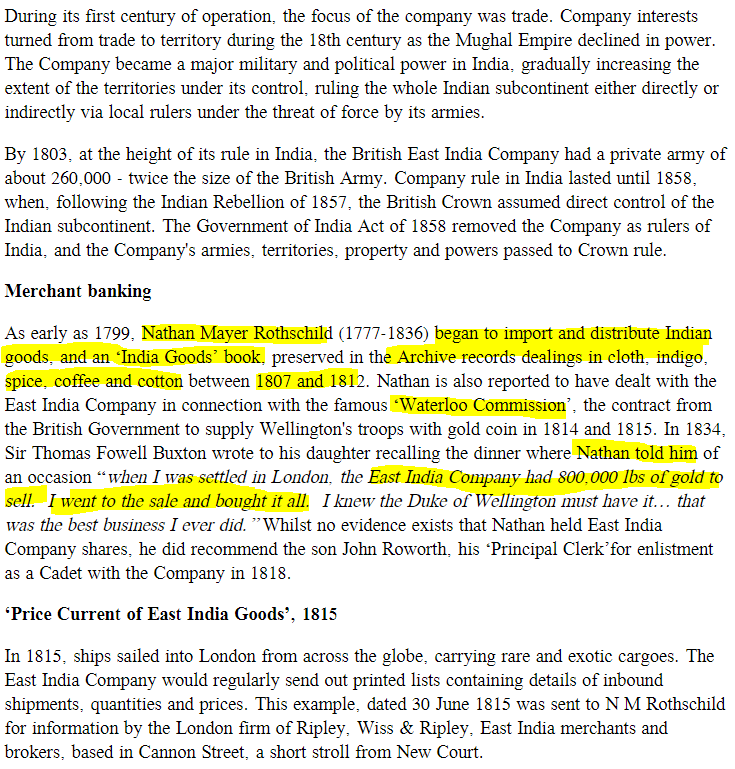
What was the Waterloo Commission? Nathan Rothschild had thrown his weight behind the Duke of Wellington. The Duke was leading a British-led coalition consisting of units from the United Kingdom, the Netherlands, Hanover, Brunswick, and Nassau against Napolean’s Army.
Nathan understood the impact of such a major so he financed the British Army under the Duke. If the Duke had lost, it would bring a certain collapse to the stockmarket. But if the Duke’s army won, that would send the stock market into a new high! So he had his network ready to provide him the fastest news of the battle. All set with the strategy, Nathan Rothschild started playing his game.
Late on the afternoon of June 18, 1815, a Rothschild representative boarded a fast schooner on the French coast and headed for England. When the news reached Nathan – a day before anyone else in the country knew – he went into the stock market and sold heavily. Other traders, following his example, sold, too. Then, late in the day, Nathan quietly returned to the market and bought all the stock he could. When the official communiqué from Waterloo arrived, the market rocketed, and Nathan had made the modern equivalent of billions. Thus was born his famous maxim: “Buy on the sound of gunfire.” (Source)
That is how Rothschild’s wealth journey started off.
What was looted by British from Tipu Sultant, who in turn had stolen from thousands of Hindu temples, became the basis of one of the largest financial empires in the world. NYT writer Aditi Natasha Kini writes about how a gold box from Tipu’s treasure landed in an auction at Christie’s
When I went to Christie’s on the day of the auction, I saw an oversize reproduction of Tipu Sultan’s 20-sided gold “magic box” in the foyer. Tipu Sultan, an 18th-century ruler of the kingdom of Mysore, the land of my ancestors, was killed by the British in the fourth Anglo-Mysore War in 1799. During hand-to-hand combat in Srirangapatna, a British soldier tried to snatch a gold buckle from Tipu’s belt. When Tipu fought back, the soldier shot him in the head. Tipu was found with “no ornament,” bare. The British, who didn’t count the heaps of corpses at Srirangapatna, did count the wealth: over a million pounds’ worth, in bags of Tipu’s gold coins, arms and armor, furniture, fine cloths and of course, jewelry. So much was taken that when a list of some objects surfaced in 2012 — a tiger’s head finial from Tipu’s wrecked throne for George III, war dresses for the Duke of York — the list itself was auctioned. (Source: New York Times)
The magic box that Aditi talked about was handed from East India Company down to the Sotheby's
Tipu’s box was passed down from Gen. Robert Bell of the East India Company to his friend Sir Charles Hopkinson, who gave the box to his great-nephew, Hans William Sotheby. His wife, Charlotte Cornish, gave the box to her second husband, Ingram Bywater, who then bequeathed it to the great-grandson of Robert Bell, Charles Francis Bell, in 1914. After that, it seems to have been sold a few times. Sotheby’s sold Tipu’s box in 2005 as part of its “exotica sale.” At Christie’s this month, the box sold to a faceless phone buyer for $495,000. (Source)
The Rich in the recent years have worked across many countries to establish their power. Please read Issue #229 - Boycotts Galore! to read how the CIA works with the latest cutting edge businesses to create a mind-boggling surveillance system while these tech firms continue to make money for their owners.
Until he was caught, even Jeffrey Epsteing was a king-maker. He ran a pedophile empire and had links with the mightiest in the world.
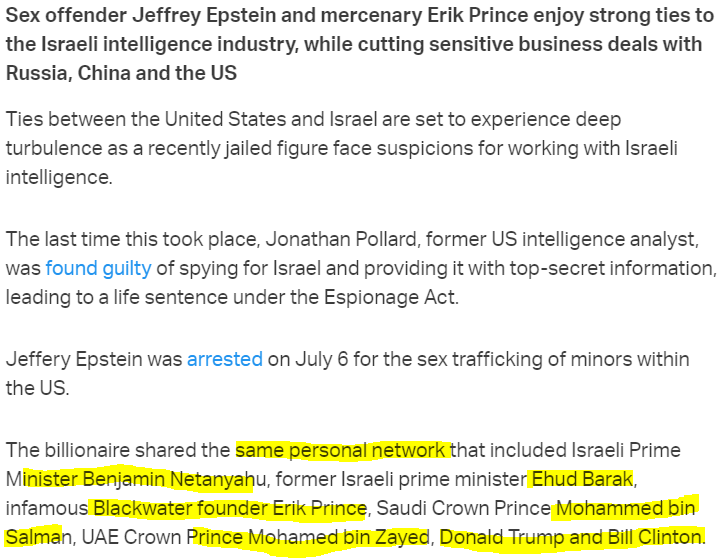
Meanwhile, CIA has been involved in propping up and backing certain companies which have taken over the world.
The CIA was the customer that launched Oracle, cofounder Larry Ellison said on stage Sunday night during the opening keynote for the company's massive customer conference in San Francisco. "Our very first customer was the Central Intelligence Agency," he said. (Source)
And, it does the same today.
Meanwhile, the CIA has continued to invest in new tech, too, everything from a massive new $600 million cloud being built by Amazon to its In-Q-Tel venture fund, which has backed nearly a 100 tech companies. (Source)
Back in the day during World War II, Victor Rothschild was part of the British Military Intelligence - the MI5.
Victor Rothschild, a member of the famous banking dynasty, was born in 1910. A talented scientist, Rothschild joined MI5 during the Second World War. This included working with Arthur Koestler to produce anti-Nazi propaganda. In 1940 Rothschild suggested that Anthony Blunt should be invited to join the secret service. He also rented a house to his friend Guy Burgess. After the liberation of France Rothschild worked with Dick White, Kim Philby and Malcolm Muggeridge at the MI6 offices established at the Rothschild family mansion in Paris. In 1961 Rothschild passed on information to Arthur Martin that Kim Philby had tried to recruit Flora Solomon, as a spy in 1937. Rothschild also worked closely with Peter Wright and is believed to have supplied him with information that suggested that Roger Hollis was a Soviet spy. (Source)
This is no different than how the Medicis had their fingers in every political, religious and business interest across Europe surely, but around the world as well. In a Russian program, the popular anchor - Pervy Kanal explains in his rather analytical program.
“Of course, if you are by far the richest family in the world, then, of course, your influence is enormous. The Rothschilds are top-notch in politics, they know exactly what will happen. Back in the century before last, Rothschild's wife Gutel Schnapper said: "If my husband does not want war, then there is no war," says political analyst Christoph Herstel. This is a typical modern caricature. The Rothschilds feed both the CIA and British intelligence Mi-6 and the terrorist group ISIS, banned in most countries of the world. Since the days of Napoleon's war with Austria, they lent money to the warring parties and the emperor and the Austrian army, having, of course, their own interest from this. The Rothschilds also had interests in Russia. “During a visit to France by Nicholas II, our sovereign, one of the Rothschilds was brought to him. He suggested: "We take control of your Central Bank in exchange for writing off debts." The sovereign said: "No!" But he stepped aside and added to his entourage: "It seems that now I have signed my own death warrant," - says the writer, historian Yuri Vorobyevsky. In the end, it all ended with a revolution in 1917. But the Rothschilds were active with us later. Although they did not appear in a single deal. Despite the fact that there were rumors of their connections with Mikhail Khodorkovsky and a number of other Russian oligarchs. (Source)
Russians resisted the Rothschilds - who the Russian anchor says have funded everyone from CIA to MI5 to the ISIS.
Apart from these political bets, the Rothschilds also own large media properties. The Rothschilds own Economist.
The Agnelli and Rothschild families will share control of The Economist after buying out Pearson’s 50 percent stake in the magazine, according to a person familiar with the sale negotiations. A deal is expected to be finalized this week that will prevent the esteemed magazine from being controlled by a single shareholder. Pearson has owned half of the Economist since 1957 but is selling its holding to concentrate on its core education business. It is expected to get between £400 million and £500 million. (Source)
And the best-known French paper, Liberation. 38.8% of shares in the paper are owned by Edouard de Rothschild.
Further talks are to take place in an effort to save one of France's best-known newspapers, the irreverent left-wing daily Liberation. Staff fear the biggest shareholder, of the Rothschild family, plans to make job cuts and a reduction in content. (Source)
The objective is clear - dominate the world via direct investments and back it up with the power of the Intelligence agencies and media.
A strategy that even George Soros uses.
Unfortunately, most of the Indian business families have made money off of patronage by Congress. What started with Gandhi and Nehru went to Indira Gandhi and the current UPA.
The initial years after the British colonial rule were spent by Congress in fattening the pockets of the large business houses - Tatas, Birlas, Mafatlals for example.
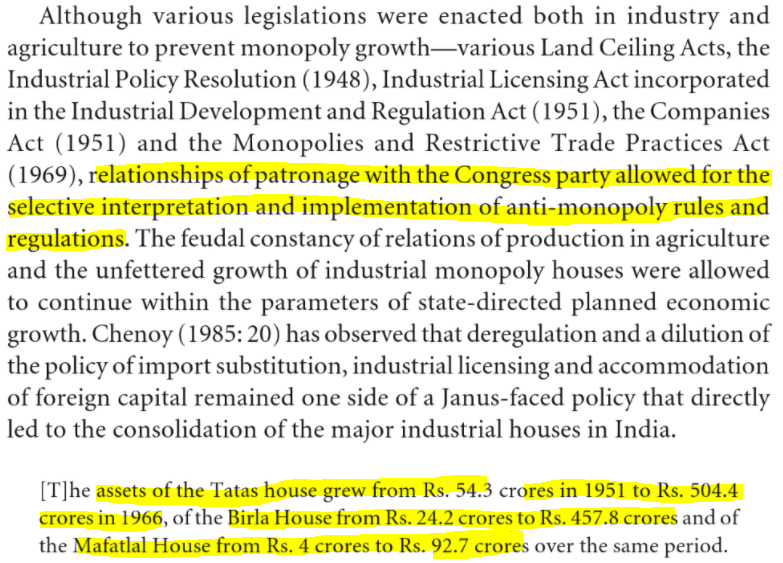
Now, the important question to ask:
Did they retain their wealth and power?
The businesses which had complete backing of one political party and its ecosystem - were they able to retain their wealth?
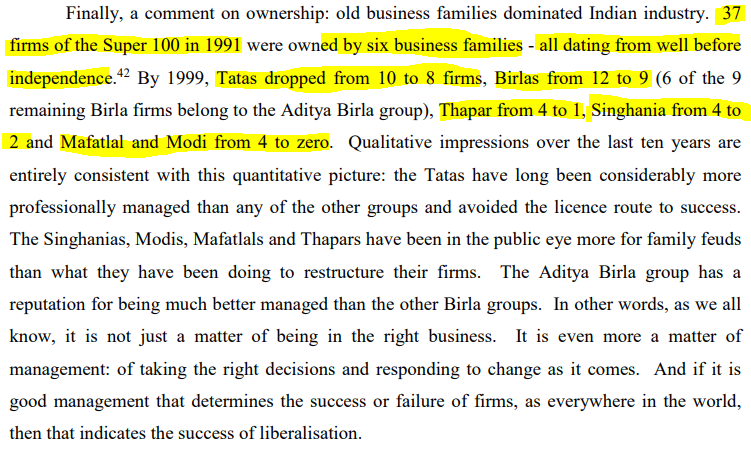
Why not?
Because they were content to play the petty local ludo while the larger geopolitical game was being dominated by other players.
These Indian super-rich were in it only for themselves. And the political honchos like the Gandhis cultivated them only for their own personal fortunes. Not for the Indian civilizational power or the nation’s strength - as was the case with, say the businessmen in US and Europe.
That is why while business families like the Rockefeller and Rothschilds have sustained their power through so many generations, the Birlas and the Mafatlals, for example, are just pale shadows of their earlier prestige.
The real reason why the Indian business families have not been the world beaters and leaders is that they have been content to play the local ludo with Congress, the Communists, the local parties, and the city establishment.
That is why it should not come as a surprise that an Assistant Police Inspector had no qualms about setting up a terror attack against the richest man in India!
Because he knew that Ambani cannot really do anything.
Had he tried this on the other global powerful elites, by now he would have been thrown into a cell so deep that no one could have found him! The narrative that would have been created against him would have buried him anyway.
The Indian business “leaders”, in reality, are just sitting ducks on the larger geopolitical chess game. They have basically grown up playing the local ludo and feeling elated at beating a nobody in the world who happened to be a big guy of his own street. When the geopolitical elite with far less wealth than them targets them, then these Indian businesses simply keep quiet and get hit like sitting ducks.
That is why ordinary “protesters” - powered by the ecosystem and network created by another billionaire - in Punjab destroyed over 1500 Jio cell towers.
And the Jio owner billionaire just kept looking over.
Vaze Diary: The National Investigation Agency (NIA) has recovered a diary from Sachin Vaze’s office which contains information on financial transactions, as per reports. The monetary transactions listed in the diary hint at the money laundering angle which is now to be investigated. The NIA is likely to approach ED to probe the financial transactions further. As per a CNN News18 report, the diary allegedly has extortion details in code words from some famous pubs and clubs in Mumbai. However, Sachin Vaze has denied having any knowledge about the diary. (Source)
Phone Data on Posting Racket: In a massive revelation, former Maharashtra Chief Minister Devendra Fadnavis claimed to have explosive evidence to prove more aspects of the mammoth Vazegate scandal and leveled some sensational charges of corruption against the Maha Vikas Aghadi government on Tuesday. Amid growing controversy over the allegations against Maharashtra Home Minister Anil Deshmukh, Fadnavis announced that he possesses 6.3 GB of phone-recording data and crucial documents pertaining to an alleged racket of transfer and posting of IPS and non-IPS officers of Maharashtra Police allegedly on the instructions of Deshmukh, along the lines of what Param Bir Singh has alleged in his plea to the Supreme Court where he has sought a CBI inquiry into his former superior Deshmukh's 'misdeeds'. (Source)
Extradition from US of Pak Terrorist: US President Joe Biden's administration has urged the US court to certify India's request to extradite Pakistani-origin Canadian businessmen Tahawwur Rana. Tahawwur Rana is sought for his involvement in the 2008 Mumbai terror attack. Assistant US Attorney John J Lulejian, in his submission before a federal US court in Los Angeles, said that Rana, who is 59-years-old, meets all the criteria to be extradited to India for his trial in the Mumbai terror attack. However, earlier on February 4, Tuhawwur Rana's attorney had opposed his extradition. (Source)
UFOs with Future Tech real: In a recent television interview, the Trump administration’s Director of National Intelligence, John Ratcliffe claimed that the United States has knowledge of ‘objects’ that can travel faster than the speed of sound without producing a sonic boom and perform maneuvers not possible with human technology. Ratcliffe further claims that many of the “UFO” incidents witnessed by U.S. officials have no easy explanation. In the interview, Mr. Ratcliffe states clearly, “There are a lot more sightings than have been made public. Some of those have been declassified. And when we talk about sightings, we are talking about objects that have seen by Navy or Air Force pilots, or have been picked up by satellite imagery that frankly engage in actions that are difficult to explain. Movements that are hard to replicate that we don’t have the technology for. Or traveling at speeds that exceed the sound barrier without a sonic boom.” (Source)
Sex in Parliament Aussie Style: Leaked videos of staff from Australia's conservative government performing sex acts in parliament, including one man masturbating over a female MP's desk, left Scott Morrison's administration facing yet another major scandal Tuesday. The prime minister -- already under pressure for his handling of sexual assault allegations including that a female government adviser was raped by a colleague -- called the behaviour "disgraceful" and "absolutely shameful". (Source)
Implant and Reverse False Memories: Oeberst is the first author of a study released Monday in the Proceedings of the National Academy of Sciences that examines false memories and what can be done to reverse them. False memories, the study suggests, are more than unsettling. When they take root, they can disrupt a courtroom — and the fate of the individuals there. In the new study, Oeberst and colleagues were able to successfully implant false memories in study subjects — and then reverse them. (Source)
There is a very intriguing structure in the Kupwara area of Kashmir. It has 7 passages, which people say are tunnels that lead to Russia.
The name of the Kalaroos village has come from the word Qil-e-Roos, which actually means Russian Fort. The Kalaroos caves are situated midway of the Lashtyal and Madhmadu villages. There is a giant stone in Lashtyal village named Satbaran. The stone has seven doors, which are known as Sath Barr. Locals say that the doors symbolise seven distinct routes to Russia and other countries. An aged native said that he had heard from his ancestors that Russians used to come through the tunnel. A few meters away from the stone are some other caves, one of them being the Tramkhan, a crimson-hued copper mine cave. Inside this cave, there is a discoloured board with some foreign language written on it. Some villagers say that the caves hide some magnificent water bodies too. Many believe that Satbaran was a temple in the ancient era where the Pandavas used to worship. (Source)
The Indian Army had demolished the main tunnel many years back so one is not sure of the veracity of the claims. This is an interesting video where a team of cavers goes inside those caves to find the truth.
Today’s ONLINE PAPER: Check out today’s “The Drishtikone Daily” edition. - THE DRISHTIKONE DAILY
Nuzzle Tweets “newsletter” - with tweets and stories that we read and follow in a day in one compilation on a daily basis - Nuzzle Drishtikone - just another way to keep up with things
SUPPORT DRISHTIKONE: If you consider our work important and enriching and would like to contribute to our expenses, please click on the button below to go to the page to send in your contribution. You can select the currency (for example, INR or USD, etc) and the amount you would like to contribute. Contribute to Drishtikone
If you like this post - please share it with someone who will appreciate the information shared in this edition.
If you like our newsletter, please share it with your friends and family